
Bouldering's my go-to for climbing without ropes, and it's a thrilling ride! I tackle short, challenging routes called problems on both natural rock and gym walls. It's all about boosting my strength, balance, and problem-solving skills. The right gear, especially snug climbing shoes and a good crash pad, keeps me safe and confident. I love the camaraderie found in bouldering communities, sharing tips, and cheering each other on. Plus, understanding the grading systems helps me track my progress. If I want to really improve, I'm always finding new techniques to enhance my skills and enjoy every ascent.
Key Takeaways
- Bouldering focuses on short, challenging routes without ropes, enhancing physical strength and mental resilience.
- Essential gear includes climbing shoes, a chalk bag, and a crash pad for safety during falls.
- Familiarize yourself with local grading systems to gauge problem difficulty and track your progress.
- Practice effective spotting techniques and fall management to prioritize safety while climbing.
What Is Bouldering?

Bouldering is an exhilarating form of rock climbing that focuses on short, challenging routes, or 'problems,' usually performed on natural rock formations or artificial walls without the use of ropes or harnesses. I love how it strips climbing down to its essence—just me, the rock, and the sheer thrill of conquering each move.
There are various types of bouldering routes, from overhangs that demand power and precision to slabs that require balance and technique. Each problem presents a unique puzzle to solve, offering both physical and mental challenges that keep me coming back for more.
The history of bouldering development is fascinating, too. It began as a way for climbers to practice techniques without the risks associated with high-altitude climbs. Over the years, it's evolved into a celebrated sport with competitions and a vibrant community.
I've found that bouldering not only builds my strength and agility but also fosters a sense of camaraderie among climbers. Whether I'm outdoors conquering a granite boulder or indoors tackling a gym wall, each ascent opens a door to freedom, adventure, and self-discovery that's hard to beat.
Benefits of Bouldering
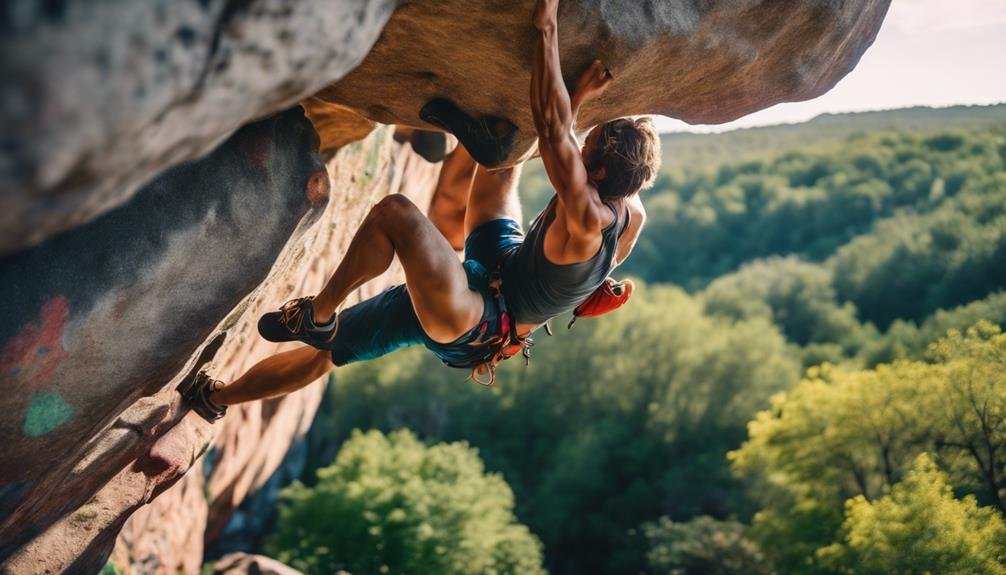
Regularly tackling bouldering problems not only boosts my physical strength but also enhances my mental resilience, making it an incredibly rewarding pursuit. Each climb challenges me to push my limits, engaging muscles I didn't know I'd while improving my balance and coordination. I can feel the rush of adrenaline as I reach for the next hold, and that sense of accomplishment is unbeatable.
Beyond the physical aspects, bouldering offers significant mental benefits. Every problem requires problem-solving skills, forcing me to think creatively and strategically. I've learned to embrace failure as part of the journey, which has taught me patience and perseverance. This mental fortitude translates into everyday life, making me more adaptable and confident.
Moreover, bouldering is a fantastic social experience. I've met a diverse community of climbers who share my passion. We cheer each other on, exchange tips, and celebrate successes together. These connections have enriched my life and made each climbing session feel like a gathering of friends.
In essence, bouldering is more than just a sport; it's a way to grow physically, mentally, and socially, all while enjoying the freedom of movement.
Essential Gear and Equipment

Having the right gear can make all the difference in my bouldering experience, ensuring safety and enhancing performance on the wall. When I gear up, I focus on a few essential items that keep me secure and confident as I tackle each climb.
The chalk bag selection is critical; I opt for one that's easy to access and fits comfortably around my waist. Quality chalk helps me maintain grip, allowing me to focus on my movements without worrying about slipping. Additionally, a reliable crash pad is non-negotiable. It cushions my falls and gives me peace of mind.
To keep the gear in top shape, crash pad maintenance is essential. I check for wear and tear and clean it regularly to ensure it performs well when I need it most. Here's a quick look at the essentials:
| Gear Item | Importance |
|---|---|
| Chalk Bag | Enhances grip and control |
| Crash Pad | Provides safety on falls |
| Climbing Brush | Cleans holds for better grip |
With the right gear, I feel free to push my limits and embrace the thrill of bouldering.
Choosing the Right Climbing Shoes

When I first started bouldering, I quickly realized that choosing the right climbing shoes can make a huge difference in my performance.
Understanding shoe fit, exploring the various types available, and considering the materials and designs all play a significant role in enhancing my climbing experience.
Let's break down these essential points to find the perfect pair for your adventures.
Shoe Fit Importance
Finding the right fit in climbing shoes can make all the difference in your bouldering experience, transforming both your comfort and performance on the wall. When I first started climbing, I didn't realize how crucial it was to have properly fitted shoes. A snug fit allows for better precision on footholds, giving me the confidence to tackle more challenging routes.
I've learned that optimizing shoe tightness is key. You want your shoes to feel secure without cutting off circulation. Using proper shoe lacing techniques can help achieve this balance. Start by loosening the laces at the toe and tightening them gradually up to the ankle, ensuring even pressure across your foot. This method not only enhances comfort but also improves control as I climb.
Types of Climbing Shoes
With the right fit in climbing shoes established, it's time to explore the various types available, each designed to suit different climbing styles and preferences.
For bouldering, I often gravitate towards aggressive shoes, which feature a downward camber that enhances precision on tiny footholds. The snug fit and rubber sole construction provide excellent grip, allowing me to push my limits without hesitation.
If I'm tackling more technical routes, I might choose moderate shoes. These offer a balance between comfort and performance, making them versatile for longer sessions.
On the other hand, beginners might prefer neutral shoes, which prioritize comfort over performance, perfect for those just starting their climbing journey.
Regardless of the type, I always consider shoe maintenance. Regularly checking the rubber for wear and cleaning them can extend their life and keep my grip reliable.
Each shoe serves a unique purpose, and understanding these differences helps me make informed choices. So, whether I'm scaling a boulder or tackling a challenging route, having the right pair of shoes can make all the difference in my climbing experience.
Material and Design Choices
Choosing the right climbing shoes involves understanding the materials and design elements that can significantly influence both performance and comfort on the wall. The upper material can vary from leather to synthetic fabrics, each offering unique benefits. Leather molds to my foot, providing a snug fit over time, while synthetic options often dry faster and offer more breathability.
The shoe's sole thickness plays a crucial role, too. Thinner soles give me better sensitivity on small footholds, while thicker soles offer more durability, which I appreciate when I'm working on rougher boulders. It's also essential to consider the shoe's closure system—Velcro is quick and convenient, but laces allow for a customizable fit.
As I gear up, I can't ignore the importance of complementary gear, like a reliable chalk bag. I look for chalk bag features like sturdy loops for easy access and ample space for my chalk. And when I'm bouldering, I never compromise on crash pad quality; a good pad protects me during falls and enhances my confidence, allowing me to push my limits. In bouldering, every choice matters—especially my shoes.
Understanding Climbing Grades
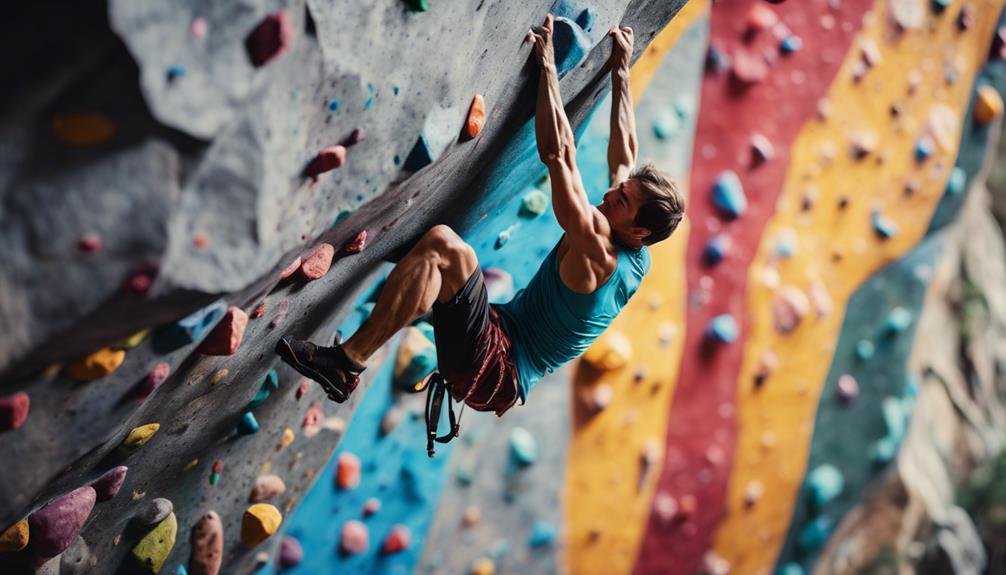
When I first started bouldering, the variety of climbing grades left me feeling a bit overwhelmed.
Understanding the different grading systems is crucial for gauging the difficulty of a problem and comparing it with others.
Let's break down how these grades work and what they really mean for our climbing journey.
Grading Systems Explained
Understanding climbing grades is essential for any boulderer, as they provide a clear benchmark for assessing the difficulty of a route and help climbers gauge their skills and progress. The bouldering grading system nuances can sometimes feel overwhelming, but knowing the basics can simplify the experience. Different regions and climbing communities often use varying systems, which can lead to bouldering grade conversion challenges.
Here's a quick overview of popular grading systems:
| Grading System | Description |
|---|---|
| V Scale | Common in the US, ranges from V0 (easiest) to V17 (hardest) |
| Fontainebleau | Used in France, ranges from 1 (easiest) to 9 (hardest) |
| Hueco Scale | Similar to V Scale but includes decimals for more precision |
As I explore various climbing areas, I find it crucial to familiarize myself with the local grading system to avoid confusion. This not only enhances my climbing experience but also ensures I can challenge myself appropriately. Embracing these grades empowers me to celebrate my progress and push my limits in the freedom of bouldering.
Difficulty Level Comparison
As I compare different climbing grades, I quickly realize that what might feel like a V2 in one area can be a completely different experience in another, highlighting the subjective nature of difficulty levels in bouldering. Each region has its own unique rock types, holds, and styles, which can dramatically influence how a problem feels. I remember struggling on a V1 that seemed easy elsewhere, only to discover that the crux relied heavily on specific technique variations I hadn't mastered yet.
This variability keeps my bouldering journey exciting and humbling. I've learned that grip strength development plays a crucial role in tackling these challenges. The more I climb, the more I understand how different holds require unique grips, whether it's pinches, slopers, or crimps.
It's essential to embrace the learning curve and adapt my techniques to each problem. By recognizing the subjective nature of climbing grades, I can appreciate the diversity of bouldering. Ultimately, it's about enjoying the freedom of movement and the thrill of conquering new challenges—regardless of the grade.
Basic Bouldering Techniques

How do I effectively use my body position and movement to conquer challenging bouldering routes?
It all starts with bouldering hand positioning. I focus on my grip, experimenting with various holds, from crimps to slopers. Each grip offers unique challenges that I embrace, allowing me to feel the rock's texture and respond intuitively.
Next, I pay attention to my bouldering core engagement. By activating my core, I maintain balance and stability, which is crucial when reaching for that next hold. I often visualize my body as a unit, moving fluidly from one point to another. When I engage my core, I feel a newfound power surging through my limbs, making those tricky moves feel effortless.
I also practice foot placements deliberately. Precision is key; I remind myself to trust my feet. Each step takes me closer to the summit, and I find joy in the rhythm of movement. As I ascend, I embrace the freedom that bouldering offers, celebrating each small victory. With the right techniques, I not only conquer the rock but also deepen my connection to this exhilarating sport.
Safety Tips for Beginners

Prioritizing safety is essential for every beginner in bouldering, ensuring I can focus on honing my skills while minimizing the risk of injury. One of the first things I learned is the importance of effective spotting techniques.
When I'm climbing, having a trusted partner to spot me makes a world of difference. They stand below, ready to guide my fall and help me land safely on the crash pads. I always remind my spotter to keep their eyes on me and to position themselves to cushion my descent if I slip.
Fall management is another crucial aspect I take seriously. I've trained myself to fall correctly—turning my body to avoid landing on my feet and rolling to dissipate the impact. This instinctive response can be a game-changer.
Before climbing, I also ensure the area is clear of obstacles and that the crash pads are placed strategically beneath the route.
Finding Bouldering Locations
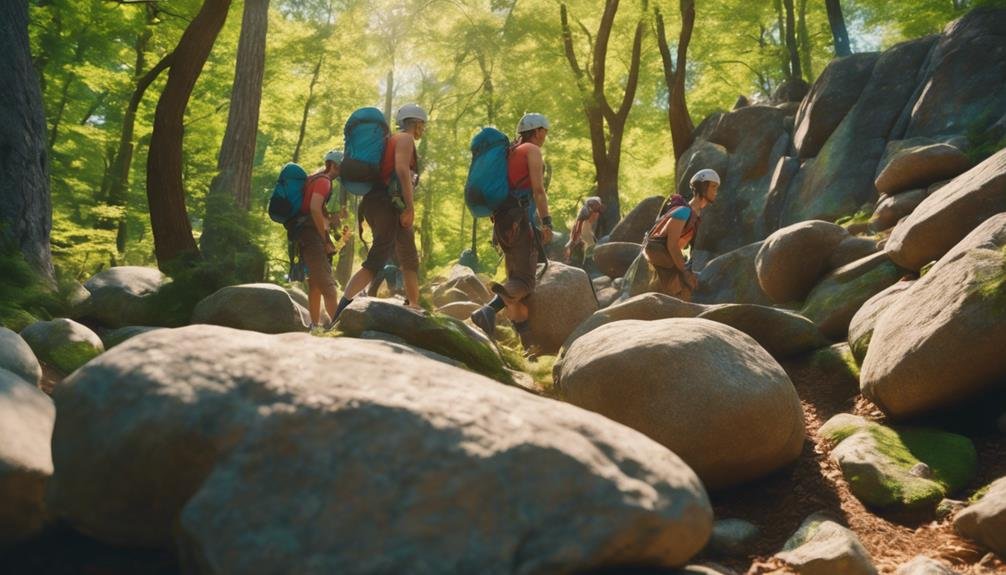
When I started bouldering, I quickly discovered that finding the right locations was key to my progress.
Local climbing gyms offered a controlled environment to hone my skills, while outdoor bouldering areas provided the thrill of nature and varied challenges.
Each spot has its own unique vibe, and exploring them has become one of my favorite parts of the journey.
Local Climbing Gyms
Exploring local climbing gyms is one of the best ways to discover vibrant bouldering communities and access a variety of climbing walls suited for all skill levels. When I stepped into my first gym, I was immediately struck by the energy buzz of climbers tackling walls of all shapes and colors. Each wall presented a new challenge, and I felt an exhilarating mix of excitement and nervousness.
Many gyms offer community classes, which are fantastic for beginners like me. These classes not only teach essential techniques but also introduce you to fellow climbers who share your passion for adventure. I found that participating in these classes fostered a sense of belonging, making it easier to connect with others.
Investing in a gym membership opened the door to countless opportunities. I could practice whenever I wanted, and the affordability meant I could climb as much as I needed to hone my skills. Plus, most gyms host regular events and competitions, which keep the community thriving.
Outdoor Bouldering Areas
After getting comfortable in the gym, I felt an undeniable pull to seek out outdoor bouldering areas, where the thrill of climbing amidst nature adds an entirely new dimension to the experience.
Venturing outside, I discovered that the world is filled with incredible bouldering destination recommendations just waiting to be explored.
Some popular bouldering areas I found include:
- Joshua Tree National Park: With its stunning rock formations and diverse problems, it's a must-visit for any boulderer.
- Squamish, British Columbia: This spot offers breathtaking views and a range of challenging routes, perfect for all skill levels.
Each location presents an opportunity to connect with nature while pushing my limits. I love how the outdoor atmosphere enhances the experience, turning each climb into an adventure. Whether I'm tackling a challenging problem or simply soaking in the scenery, outdoor bouldering fills me with a sense of freedom I can't find anywhere else.
Joining a Bouldering Community
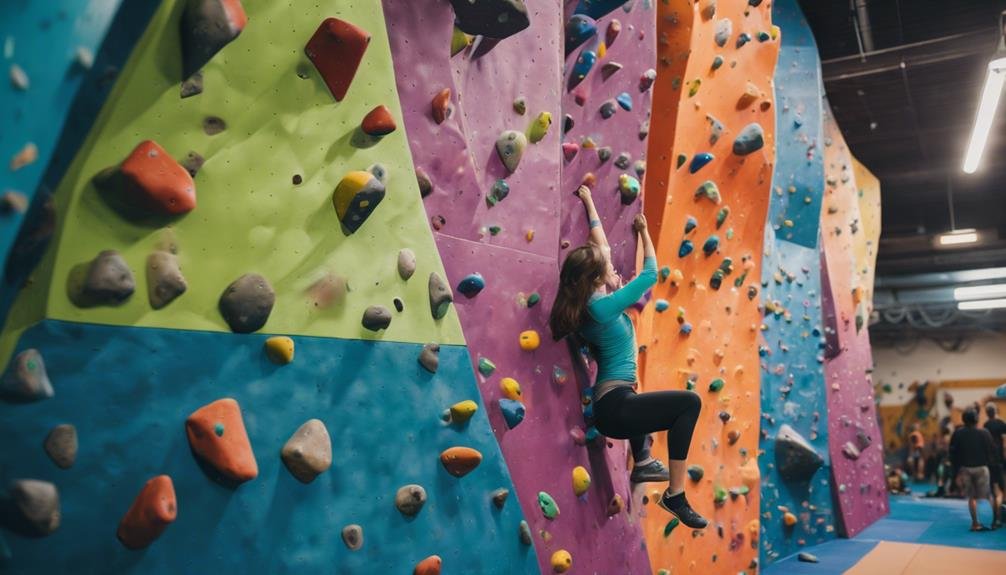
Joining a bouldering community can transform your climbing experience, providing not just support and motivation, but also friendships that make each ascent even more rewarding. When I first stepped into the climbing gym, I felt a mix of excitement and nervousness.
But as I started connecting with fellow climbers, I realized that everyone shared the same passion for adventure and freedom. Making new climbing friends is one of the best parts of bouldering. We cheer each other on as we tackle challenging routes, sharing tips and celebrating victories, big and small.
I've found that cultivating a supportive community creates an environment where we all thrive. It's exhilarating to witness others push their limits, and it inspires me to do the same. Joining group sessions or local climbing events can be a great way to meet others.
You'll discover a wealth of knowledge and experience that can enhance your bouldering journey. Plus, the bonds you form can lead to trips to stunning outdoor locations, where the thrill of climbing is even more exhilarating. Embrace the community; it's an integral part of the bouldering experience that makes each climb unforgettable.
Progressing Your Skills
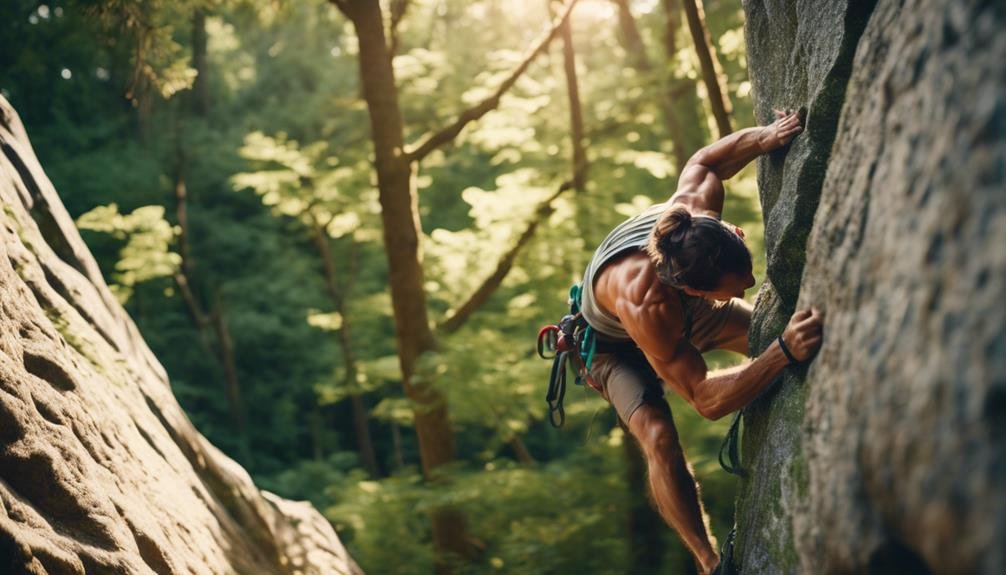
Progressing my bouldering skills requires a mix of dedication, practice, and the willingness to step outside my comfort zone. Every time I approach a new problem, I remind myself that it's not just about reaching the top but also about refining my technique. I focus on technique progression, breaking down movements and analyzing my body positioning.
To truly develop my skills, I've found it helpful to:
- Set specific goals: Whether it's tackling a particular grade or mastering a technique, having clear milestones keeps me motivated.
- Experiment with different styles: Trying various climbing techniques not only improves my adaptability but also adds fun to the process.
With every climb, I embrace the challenges that come my way. It's about more than just strength; it's about fluidity and strategy. By continuously pushing my limits, I find freedom in movement and a deeper connection to the climbing community. Each session is an opportunity to learn and grow, and that's what makes bouldering so exhilarating.
Conclusion
As I step off the crash pad, the thrill of bouldering washes over me like a gentle tide, urging me to climb higher.
Each ascent feels like a mini odyssey, where I discover not just the rock, but also my own strength and resilience.
The camaraderie within the bouldering community is like a warm campfire, inviting and vibrant.
If you're ready to embrace your own adventure, grab your shoes and let the journey begin!
